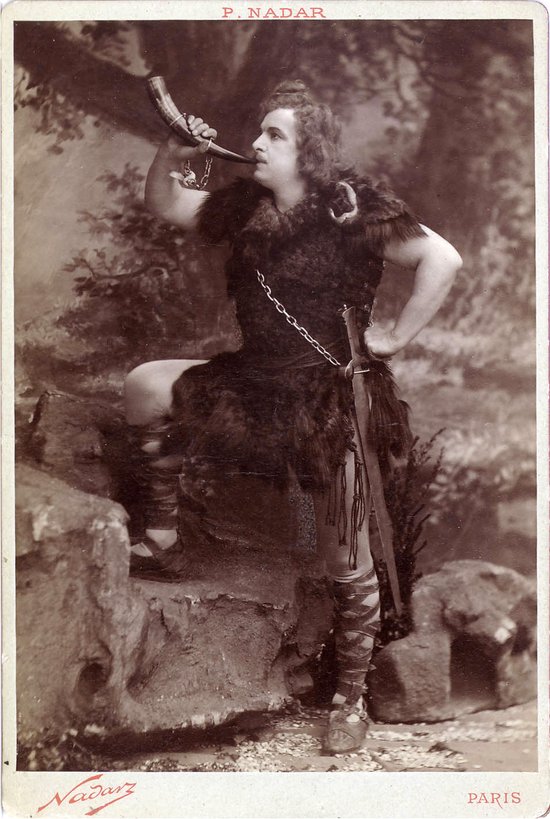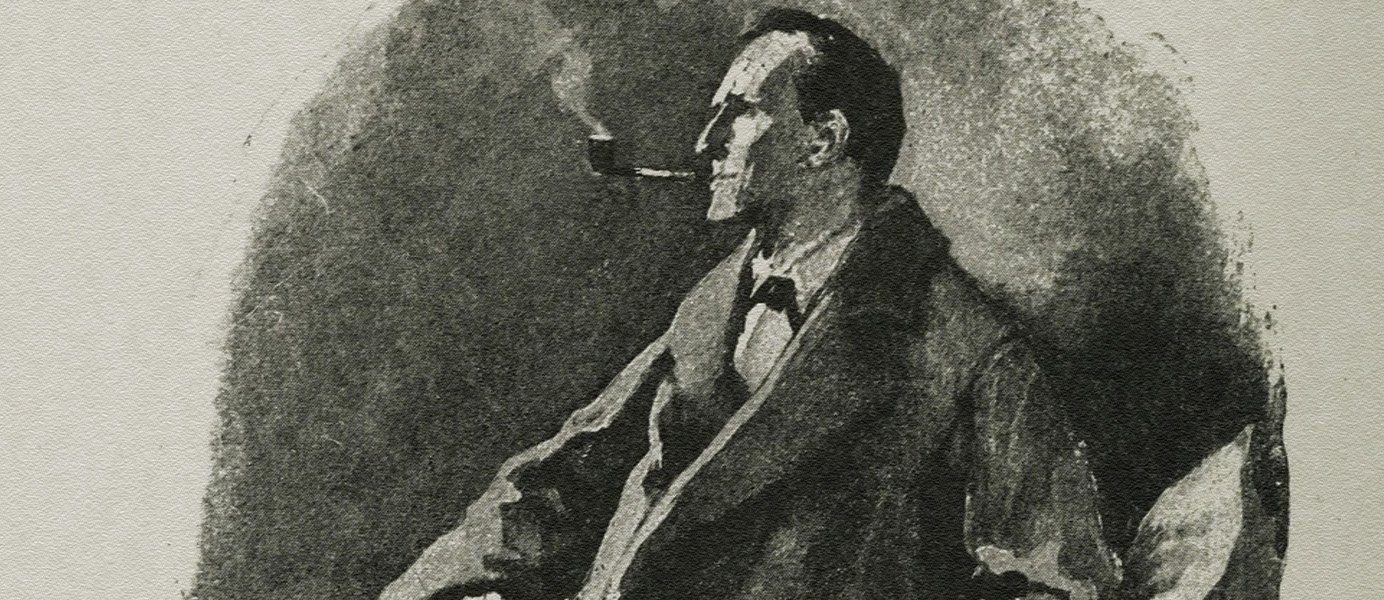In the footsteps of Sherlock Holmes
Even though Arthur Conan Doyle never set foot in Poland, he wrote about Warsaw and Gdansk in his adventures of Sherlock Holmes. The writer also immortalised two famous Polish opera singers – Jan and Edward Reszke.
Is there anyone who has not heard about the adventures of Sherlock Holmes? Even if you have never read any of Arthur Conan Doyle’s novels, one is sure to recognise the depiction of the famous London detective has shown on numerous portraits. A tall slim figure with an elongated face and aquiline nose, wearing his characteristic trench coat and tweet plaid cap, smoking a pipe or holding a violin in his hand, Holmes is usually in the company of his faithful friend and the chronicler of his adventures – Doctor John Hamish Watson. His London flat at Baker Street 221B is one of the best known addresses in the history of world literature. Stories about the adventures of Holmes and Watson have been many times reprinted and translated into many languages. They have also been turned into cartoons and adapted for television and the cinema.
 Physician by profession, writer by vocation
Physician by profession, writer by vocation
Sherlock Holmes’s literary father was born on 22 May 1859 in Edinburgh as Arthur Ignatius Conan Doyle, the second of seven children of Mary Foley and Charles Altamont Doyle. “Of my boyhood I need say little, save that it was Spartan at home and more Spartan at the Edinburgh school where a tawse-brandishing schoolmaster of the old type made our young lives miserable,” he wrote in his autobiography Memoirs and Adventures. In his home town, Doyle completed his medical studies and opened his own practice. In 1900 and 1906, he stood for Parliament for the Liberal Unionist Party, whose members opposed giving Ireland autonomy leading to the dissolution of the United Kingdom of Great Britain and Ireland.
Arthur Conan Doyle travelled extensively around the world. As a young doctor he travelled to the Arctic on a whaling ship named Hope and then on a commercial ship Mayumba to West Africa. He visited Egypt and Sudan, western Europe, the United States, Canada, Australia, and New Zealand. He continued to study medicine, but his love for literature ultimately prevailed. With the encouragement and support of his wife Louisa Hawkins, he decided to leave medicine for good and to take up writing. Even though today he is best-known for his adventures of Sherlock Holmes, he also wrote science fiction novels (The Lost World, The Poison Belt), historical novels (The White Company, The Refugees), as well as poetry. King Edward VII was a great admirer of his talent and knighted him in 1902 for his participation in the Second Boer War and for writing about it in his book The Great Boer War.
The Birth of Sherlock Holmes
Sherlock Holmes, the eccentric detective, was born as a literary figure in November 1887, when Beeton's Christmas Annual published the novel A Study in Scarlet, in which he made his first appearance. “First it was Sherringford Holmes; then it was Sherlock Holmes. He could not tell his own exploits, so he must have a commonplace comrade as a foil—an educated man of action who could both join in the exploits and narrate them. A drab, quiet name for this unostentatious man. Watson would do,” wrote Doyle.
Before Ward, Lock & Co. bought the manuscript for 25 pounds, the novel had been rejected by many other publishers. Holmes’s adventures had modest beginnings; the novel, even though it became an instant hit with readers, was written off by literary critics. In 1891, undeterred by his initial lack of success, Doyle decided to write more short stories featuring Sherlock Holmes for “The Strand Magazine” – A Scandal in Bohemia and The Red-Headed League. This time the short stories were received enthusiastically. Unlike his readers, the writer did not think that The Adventures of Sherlock Holmes was his best work. “All things find their level, but I believe that if I had never touched Holmes, who has tended to obscure my higher work, my position in literature would at the present moment be a more commanding one,” Doyle wrote.
Sherlock Holmes was inspired by Professor Joseph Bell, a Scottish surgeon, a University of Edinburgh lecturer, and Arthur Conan Doyle’s teacher. As a clinical doctor and forensic medicine expert, he applied the method of deduction and shrewd observation. “Bell was a very remarkable man in body and mind,” wrote Doyle. “He was a very skilful surgeon, but his strong point was diagnosis, not only of disease, but of occupation and character. (...) It is no wonder that after the study of such a character I used and amplified his methods when in later life I tried to build up a scientific detective who solved cases on his own merits and not through the folly of the criminal.” Doctor Watson bears surprisingly many similarities to Doyle himself. “I have often been asked whether I myself had the qualities I depicted, or whether I was merely Watson,” the writer recalled.
For many readers the detective from Baker Street was not a literary hero, but a real person. In many letters people asked for his address and autograph. They also asked the detective for help in examining and solving various family mysteries. “Once the offer—from Poland—was that I should go over myself, and my reward was practically left to my own judgment. I had judgment enough, however, to avoid it altogether,” Doyle recalled.
The writer never visited Poland, but he did mention two Polish cities – Warsaw and Gdansk in his adventures of Sherlock Holmes. These are not the only Polish elements that a reader may find in his books.
Trail one: The Adventure of the Naval Treaty
During one of his adventures, Holmes presented the circumstances of a complicated case to two clients: Monsieur Dubugue of the Paris police, and Fritz von Waldbaum, “the well-known specialist of Gdansk.” As Doctor Watson recalled, “both of whom had wasted their energies upon what proved to be side-issues.”
The short story called The Adventure of the Naval Treaty was first published in “The Strand Magazine” in London in 1893. The reader should not be surprised by the German-sounding name of the specialist from Danzig. After the Vienna Congress (1815), which established new borders in Europe, Gdansk came under Prussian rule. We can presume that Arthur Conan Doyle had very good knowledge of history and geography.
Still as a doctor and later as a writer and lecturer on spiritualism, he travelled extensively, visiting some countries several times. He had never been to the Polish Kingdom, the Kingdom of Prussia or to independent Poland after 1918. Scots began to immigrate to our country in the 14th century and continued to do so during Doyle's lifetime. Called Szots in Poland, they settled mainly in Gdansk. Most of them were merchants and in the 19th century they worked in the textile and metallurgy industries, and as farmers and engineers. Many of them became assimilated and changed their surnames to Polish sounding names. “And for áuspicuousness, I may rather tearme it to be a Mother and Nurse, for the youth and younglings of Scotland, who are yearely sent hither in great numbers, than a proper Dame for her owne birth; in cloathing, feeding, and inriching them with the fatnesse of her best things; besides thirty thousand Scots families, that live incorporate in her bowells. And certainely Polland may be tearmed in this kind to be the mother of our Commons, and the first commencement of all our best Merchants' wealth, or at least most part of them,” wrote the Scottish author and traveller William Lithgow in 1616.
Trail two: A Scandal in Bohemia
The famous master of intrigues Irene Adler was a very important character in The Adventures of Sherlock Holmes. She was an American singer with a contralto voice. A beautiful woman of great willpower and a strong mind, she would do anything to accomplish her goal. In the short story A Scandal in Bohemia we learn that Wilhelm Gottsreich Sigismond von Ormstein, Grand Duke of Cassel-Felstein and King of Bohemia, met her during a longer sojourn in Warsaw, where she was a prima donna. In the English original, the singer performed at the Imperial Opera of Warsaw – a fictitious place, but only in name. At the time when Adler successfully performed on stage, the Grand Theatre with an opera house existed in Warsaw. The cornerstone for the Grand Theatre was laid on 19 November 1825 in the presence of the government of the Polish Kingdom, actors and a large crowd of Varsovians. The monumental building of the National Theatre was designed by the architect Antonio Corazzi. Its construction was completed in 1833. Tsar Nicholas I ordered the name of the theatre to be changed to the Grand Theatre and did not agree for a Polish opera to be staged at its opening. Thus, on 24 February 1833, the Grand Theatre staged Gioachino Rossini’s The Barber of Seville for its inauguration.
At the time when Irene Adler performed on the stage in the short story A Scandal in Bohemia, the opera house’s director was Cesare Trombini, an Italian. Warsaw’s opera house produced Lohengrin and Tannhäuser, operas written by Richard Wagner, whom Sherlock Holmes particularly admired. Its opera productions included appearances by such excellent signers as Józefina Reszke, Helena Hermanówna, Marcella Sembrich-Kochańska and Bronisława Dowiakowska. Irene Adler abandoned her opera singing career around 1883. She shared a special bond with the London detective. “To Sherlock Holmes she is always the woman. I have seldom heard him mention her under any other name. In his eyes she eclipses and predominates the whole of her sex. It was not that he felt any emotion akin to love for Irene Adler. [...] And yet there was but one woman to him, and that woman was the late Irene Adler, of dubious and questionable memory,” recalled Watson.
 Trail three: The Hound of the Baskervilles
Trail three: The Hound of the Baskervilles
A Polish element also appears in the novel The Hound of the Baskervilles. Sherlock Holmes, who had come to be known as a music lover, a talented violinist and composer, turns to Doctor Watson and says: “I have a box for Les Huguenots. Have you heard the de Reszkes?” The famous detective was referring to the outstanding Polish singers: Jan Mieczysław and Edward August, known abroad as Jean and Édouard de Reszke.
Even though only Jan (born on 14 January 1850), Edward (born on 22 December 1853) and their sister, Józefina, a soprano (born on 4 June 1855) were successful performers, the whole Reszke family was very musical. Their father Jan, a justice of the peace, owner of the Hotel de Saxe and a house at Kozia Street in Warsaw, and a railroad inspector was a baritone. His wife Emilia, whose maiden name was Ufniarska, was a mezzo soprano. The oldest daughter Emilia and the youngest son Wiktor were also talented singers. Every Friday concerts were organised at the house at Kozia Street, attended by vocally talented guests. Evenings started with tea and then guests proceeded to a drawing room where they played music. Arias and duets were sung and when more guests arrived – choral music was performed. Concerts would end at eight o’clock, after which guests were invited for dinner. Jan and Emilia also performed at charity concerts. Their two sons – the gifted with a lyric and dramatic tenor voice Jan and the excellent bass Edward – were considered the best opera singers of their time. Teatro la Fenice in Venice, the Paris Opera and the Metropolitan Opera in New York or the Royal Opera House in London – these are just a few of the world stages at which they gave wonderful performances of opera arias. On 11 July 1887, the London performance of Giacomo Meyerbeer’s Les Huguenots was considered the best spectacle of the season. Jan Reszke was the lead singer in that performance. In later years, the brothers often performed together. In Les Huguenots in Covent Garden, Jan performed as Raoul de Nangis, and Edward as Graf von Saint-Bris and Marcel alternatively. Perhaps Arthur Conan Doyle heard them sing and decided to immortalise the brothers in his novel The Hound of the Baskervilles, published in 1902.
The writer was fascinated with the period of Louis XIV, specifically the story of the Huguenots, followers of Calvin, who were persecuted by the French authorities and the Catholic Church. This interest was reflected in his historical novel The Refugees. A Tale of Two Continents. “Soon after its appearance it was translated into French, and my dear old mother, herself a great French scholar, had the joy when she visited Fontainebleau to hear the official guide tell the drove of tourists that if they really wanted to know about the Court of the great monarch, they would find the clearest and most accurate account in an Englishman’s book, The Refugees,” Doyle wrote.
Queen Victoria was also an admirer of the vocal talent of the brothers. In 1889 after the premiere of The Master-Singers of Nuremberg by Richard Wagner, the Queen invited Jan and Edward to the Windsor Castle, where, joined by the soprano singer Emma Albani, they gave an improvised concert. From then onwards, the Reszke brothers had been friends of the Queen and the Prince of Wales Albert Edward, who later became King Edward VII. And thanks to the Poles’ extraordinary talent, going to the opera once again became popular among London’s upper class.
Author: Katarzyna Dzierzbicka
Source: “Rzeczpospolita”

04.09.2017







